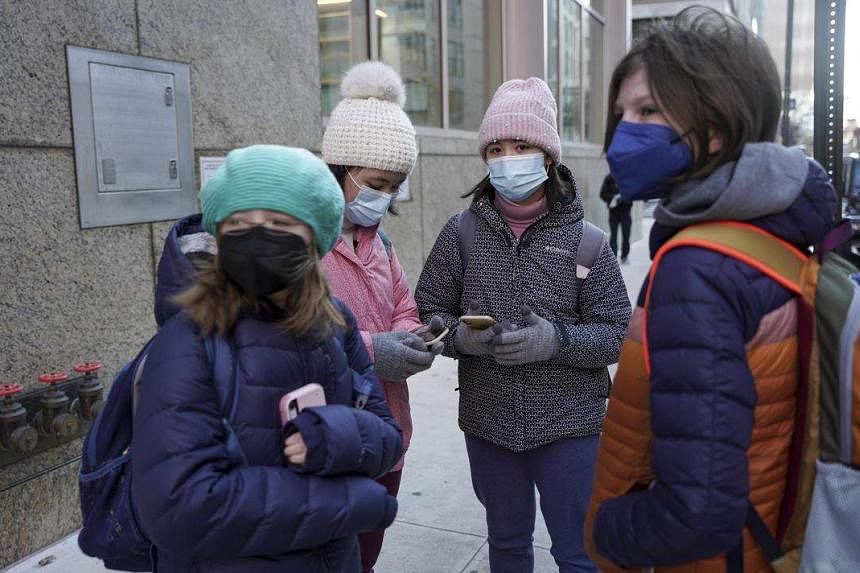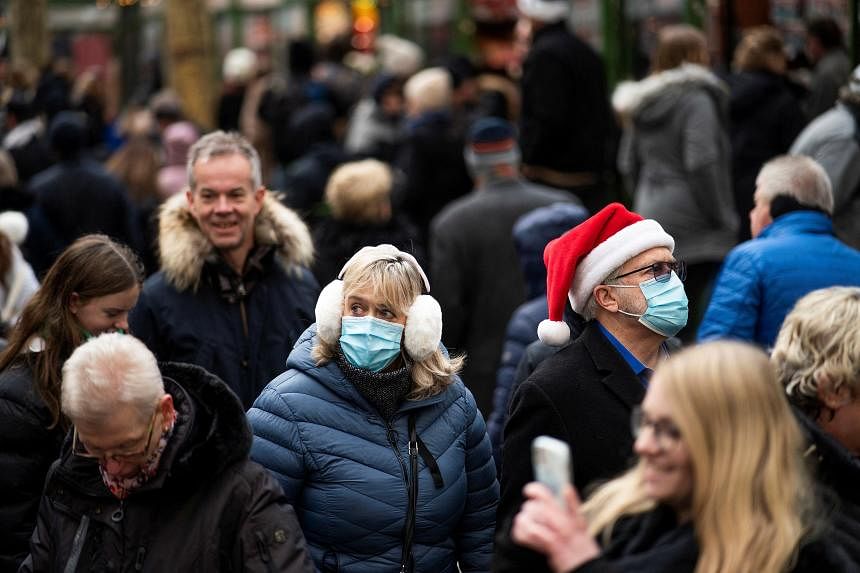NEW YORK - Masks are back and, this time, they are not just for Covid-19.
A “tripledemic” of the coronavirus, influenza and respiratory syncytial virus, or RSV, sweeping through the United States has prompted several cities and counties, including New York City and Los Angeles County, to encourage people to wear a mask in indoor public spaces once again.
Nationwide, over the past two weeks, Covid-19 case rates have spiked by 56 per cent, and hospitalisations by 24 per cent.
The Centres for Disease Control and Prevention (CDC) estimates that there have already been 13 million illnesses and 7,300 deaths from flu this season, and those numbers are expected to rise in the coming months.
Over the past decade, annual flu deaths have ranged from 12,000 to 52,000 people, with the peak in January and February. And while RSV finally appears to be on the decline, infection rates are still high across much of the country.
The CDC officially advises wearing a mask on a county-by-county basis, depending on community Covid-19 levels, which take into account virus-related hospital admissions, bed capacity and case rates.
But in an interview with NPR last week, CDC director Rochelle Walensky said: “You don’t need to wait for CDC’s recommendation, certainly, to wear a mask.”
Rates of Covid-19, flu and RSV “may be more intense or a little bit less intense in some parts of the country, but really, the entire country is being affected”, said Dr William Schaffner, a professor of preventive medicine at the Vanderbilt University School of Medicine.
He urged anyone who lives in a high-risk household to “put your mask back on” in public spaces.
High-risk households would include those with adults above the age of 65, pregnant women, people with a pre-existing condition such as heart disease, diabetes or lung disease, and anyone who has a weakened immune system.
Dr Helen Chu, an associate professor of allergy and infectious diseases at UW Medicine in Seattle, went a step further, recommending that everyone wear a mask while infection and hospitalisation rates are so high.
“I think it’s a good time to mask,” she said. “Given where we are right now, with hospitals being at very close to capacity, especially in paediatric hospitals, with RSV and with flu, I think that anything that you can do to slow down community transmission is going to be helpful.”
There is strong evidence that masks help to reduce the transmission of several respiratory viruses.
One paper published in 2020 by researchers in Hong Kong showed that people sick with either Covid-19 or flu breathed out fewer viral particles when they were wearing a surgical mask.
Masks were found not to be as effective for the rhinovirus, though, which causes the common cold.
A study of Covid-19 policies in Boston-area schools found removing a mask mandate in 2022 was tied to nearly 12,000 additional cases among students and staff.
Rates of influenza and other respiratory viruses essentially flattened during the 2020 and 2021 winter seasons, and this was largely attributed to the protections taken to prevent the spread of Covid-19.
“What Covid-19 has shown us, because we’ve been social distancing and mask wearing, is that influenza, the common cold viruses, RSV are suppressed remarkably” by these small individual behaviours, Dr Schaffner said.
Masks work by filtering out both the tiny aerosol particles through which the coronavirus is primarily spread and the larger droplets that are thought to be responsible for most influenza and RSV transmission.
They also stop you from touching your face in case you have picked up virus particles on your hands from a doorknob or subway pole.
And while masks are most effective at stopping the spread of these viruses when the infected person is wearing one, masking to protect yourself from disease is still beneficial, particularly if you are using a high-quality version, such as N95, KN95 or KF94.
“The basic truth is that masks work,” said Ms Syra Madad, senior director of the systemwide special pathogens programme at New York City Health + Hospitals.
“Whether you’re talking about Covid-19 or other respiratory viruses like RSV and flu, wearing a mask will help protect you against all these respiratory viral illnesses.”
Other public health measures, such as hand washing, surface wiping and air filtration, are also important to limit the spread of respiratory viruses.
Special emphasis has been placed on vaccination, especially by the White House and the CDC, and you should absolutely get a flu shot and the latest Covid-19 booster if you have not already.
But vaccines are best thought of as protection against severe illness if you do get infected with a virus. Masks are the first line of defence against transmission.
“Frankly, to prevent transmission, neither antivirals nor vaccines have done a great job,” said Dr Abraar Karan, an infectious disease fellow and postdoctoral researcher at Stanford Medicine. “What prevents transmission is actually masking and likely air filtration.”

When weighing when and where to mask, Ms Madad recommended paying attention to the Three Cs: close contact, crowded spaces and confined places with poor ventilation.
The experts urged wearing masks while travelling on planes and public transportation, and they strongly suggested doing it while out shopping for groceries and gifts.
For smaller holiday parties with people you know, it is fine to forgo masks if guests test beforehand and stay home if they are feeling rundown.
Realistically, not everyone in the United States – or a certain city – will wear a mask.
In fact, you might find yourself the only person in a store or on a plane who is wearing one. Do not let that discourage you.
For one thing, remember that no one is thinking about you as much as you think they are. In social psychology, this is called the spotlight illusion, said Dr Gretchen Chapman, a professor of social and decision sciences at Carnegie Mellon University.
“I may feel that everyone’s staring at me because I’m wearing a mask, but chances are that’s like the 11th thing on their list to worry about,” she said.
Furthermore, Dr Chapman said: “There are lots of situations in life where we do something that makes us feel awkward, but if we think it’s important enough, we do it anyway.” NYTIMES

